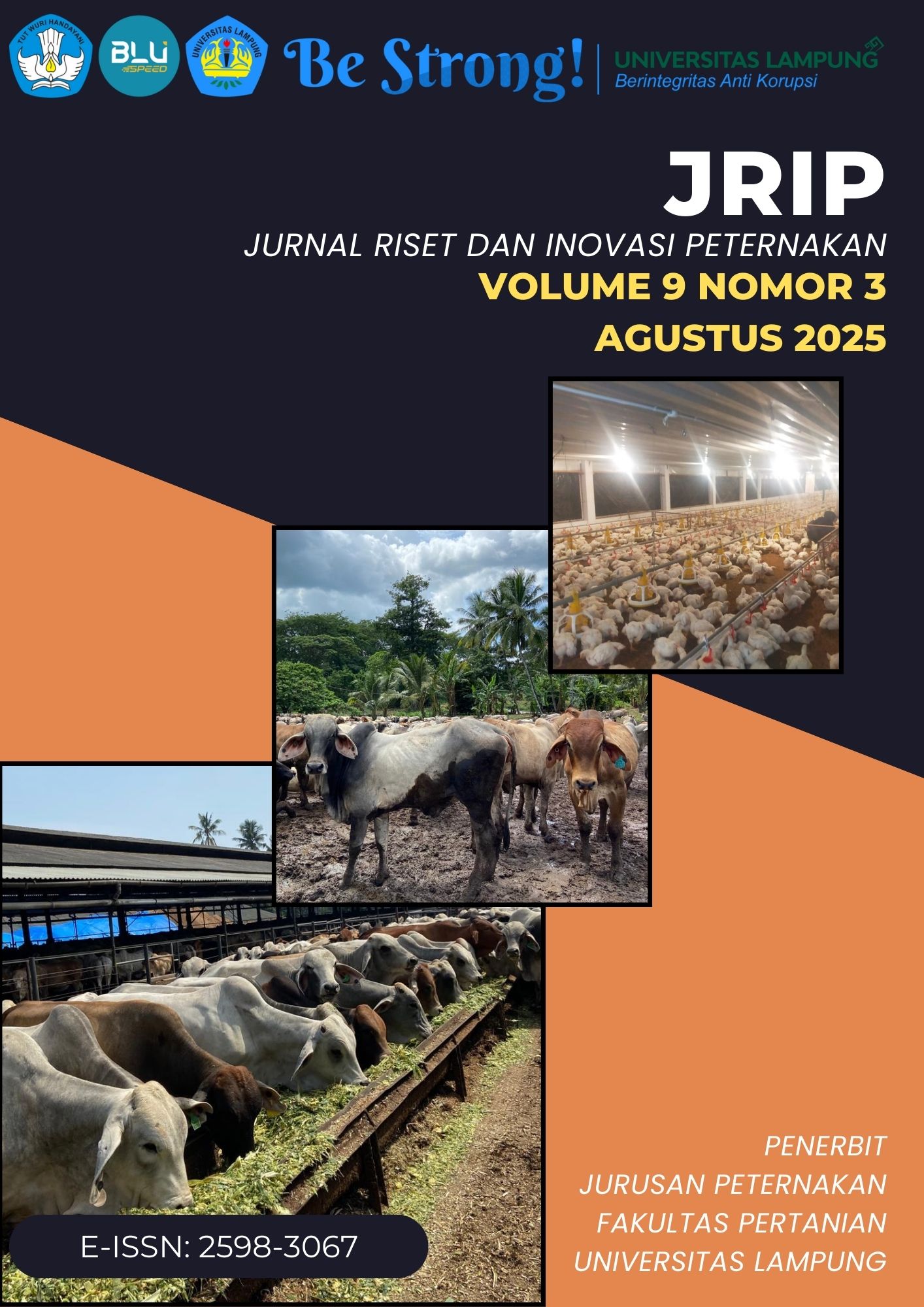Pengaruh Konsentrasi dan Frekuensi Penyiraman Urine Kambing pada Level Berbeda terhadap Produktivitas Rumput Pakchong
Abstract
Penelitian ini bertujuan untuk mengetahui interaksi dan pengaruh dari konsentrasi dan frekuensi penyiraman urine kambing dengan level berbeda mengenai produktivitas rumput Pakchong. Penelitian ini dilakukan pada Oktober-Desember 2024 di Rumah Kaca Laboratorium Lapang Terpadu dan di Laboratorium Nutrisi dan Makanan Ternak Jurusan Peternakan Fakultas Pertanian Universitas Lampung. Penelitian ini menggunakan Rancangan acak lengkap (RAL) Faktorial yang terdiri atas faktor konsentrasi urine dan frekuensi penyiraman. Faktor konsentrasi urine terdiri dari 4 taraf perlakuan yaitu K0: Tanpa urine (kontrol), K1 : 10%, K2 : 20%, dan K3: 30% dan faktor frekuensi penyiraman terdiri dari 3 faktor yaitu F1: setiap 5 hari, F2: setiap 10 hari, dan F3: setiap 15 hari. Data dianalisis menggunakan ANARA dan dilanjutkan dengan uji lanjut Beda Nyata Terkecil (BNT). Hasil penelitian menunjukkan bahwa perlakuan konsentrasi dan frekuensi penyiraman urine kambing tidak memberikan interaksi yang nyata (P>0,05) terhadap rata-rata jumlah anakan, bobot segar dan bahan kering rumput Pakchong. Hasil uji BNT (Beda Nyata Terkecil) pada bahan kering menunjukkan bahwa perlakuan K1 berbeda nyata (P<0,05) dengan perlakuan K0 dan K2. Selanjutnya pemberian K3 tidak berbeda nyata (P>0,05) dengan perlakuan K1 tetapi berbeda nyata (P<0,05) dengan perlakuan K0 dan K2.
Downloads
References
Ahmed, E. E., Bisztray, G. D., & Velich I. (2002). Plant Regeneration from Seedling Explants of Common Bean (Phaseolus Vulgaris L.). Proceedings of the 7th Hungarian Congress on Plant Physiology, 46(3-4), 27-28. https://abs.bibl.u-szeged.hu/index.php/abs/article/view/2228
Ahmed, S., Rezaul, M., Rakib, H., Ahmed, S., Rakib, M., & Jalil, M. A. (2021). Forage growth, biomass yield and nutrient content of two different hybrid Napier cultivars grown in Bangladesh. Bangladesh Journal Of Animal Science. 50(1), 43-49. https://www.researchgate.net/publication/354724562
Brumos, J., Robles, L. M., Yun, J., Vu, T. C., Jackson, S., Alonso, J. M., & Stepanova, A. N. (2018). Local Auxin Biosynthesis is a Key Regulator of Plant Development. Developmental Cell, 47(3), 306-318. https://doi.org/10.1016/j.devcel.2018.09.022
Jumini, Har, H., & Armis. (2012). Pengaruh Interval Waktu Pemberian Pupuk Organik Cair Enviro terhadap Pertumbuhan dan Hasil Dua Varietas Mentimun (Cucumis Sativus L.). Jurnal Floratek, 7, 133-140.
Kusuma, A. S. (2010). Pengaruh Zat Pengatur Tumbuh Rootone- F Dan Naa Terhadap Keberhasilan Tumbuh Stek Manglid (Magnolbi Blumei Prantl). Skripsi. Institut Pertanian Bogor. Bogor.
Kusuma, A. S. (2010). Pengaruh Zat Pengatur Tumbuh Rootone- F Dan Naa Terhadap Keberhasilan Tumbuh Stek Manglid (Magnolbi Blumei Prantl). Skripsi. Institut Pertanian Bogor. Bogor.
Liman, Wijaya, A. K., Erwanto, Muhtarudin, Septianingsih, C., Asidiq, T., Nur, T., & Adhianto, K. (2022). Productivity and Quality of Pakchong-1 Hybrid Grass (Pennisetum purpureum × Pennisetum americanum) at Different Harvesting Ages and Fertilizer Levels. Pakistan Journal of Biological Sciences, 25(5), 426-432. https://doi.org/10.3923/pjbs.2022.426.432
Niagara, J. A., Sulistyono, A., & Santoso, J. (2018). Pengaruh Pemberian Macam Hormon dan Konsentrasi Terhadap Perkecambahan Kopi Liberika. Plumula, 6(2), 68-78.
Ressie, M. L., Mullik, M. L., & Dato, T. D. (2018). Pengaruh Pemupukan dan Interval Penyiraman terhadap Pertumbuhan dan Produksi Rumput Gajah Odot (Pennisetum purpereum cv Mott). Jurnal Sain Peternakan Indonesia, 13(2), 182-188. https://doi.org/10.31186/jspi.id.13.2.182-188
Rosalina, F. (2016). Pengaruh Konsentrasi ZPT dan Jumlah Mata tunas terhadap Pertumbuhan Stek Melati (Jasminum sambac). Skripsi. Sekolah Tinggi Ilmu Pertanian Dharma Wacana Metro. Lampung. .
Safitri, R., Rahayu, T., & Widiastuti, L. (2021). Pengaruh Macam Media Tanam dan Konsentrasi Zat Pengatur Tumbuh Terhadap Pertumbuhan Stek Dua Nodus Melati. Kultivasi, 20(1), 22-26. https://doi.org/10.24198/kultivasi.v20i1.29419
Schaller, G. E., Bishopp, A., & Kieber, J. J. (2015). The yin-yang of hormones: Cytokinin and auxin interactions in plant development. Plant Cell, 27(1), 44-63. https://doi.org/10.1105/tpc.114.133595
Shrivastav, P., Prasad, M., Singh, T. B., Yadav, A., Goyal, D., Ali, A., & Dantu, P. K. (2020). Role of Nutrients in Plant Growth and Development In Contaminants in Agriculture (M. Naeem, A. A. Ansari, & S. S. Gill, Eds.). Springer International Publishing.
Sinay, H. (2011). Pengaruh Giberelin dan Temperatur Terhadap Pertumbuhan Semai Gandaria (Bouea macrophylla Griffith.). Bioscientiae, 8(1), 15-22. http://www.unlam.ac.id/bioscientiae
Suwandi, & Nurtika, N. (1987). Pengaruh Pupuk Biokimia “Sari Humus” pada Tanaman Kubis. Buletin Penelitian Hortikultura , 213-318.
Viza, R. Y., & Ratih, A. (2018). Pengaruh Komposisi Media Tanam dan ZPT Air Kelapa terhadap Pertumbuhan Setek Pucuk Jeruk Kacang (Citrus reticulata Blanco). Jurnal Biologi Universitas Andalas, 6(2), 98-106. http://jbioua.fmipa.unand.ac.id/index.php/jbioua/index
Wuriesyliane, & Sawaluddin. (2022). Aplikasi Berbagai Konsentrasi Zat Pengatur Tumbuh (ZPT) terhadap Pertumbuhan dan Hasil Tanaman Baby Buncis (Phaseolus culgaris L.). Jurnal Planta Simbiosa, 4(1), 64-70. https://doi.org/10.25181/jplantasimbiosa.v4i1.2512
Copyright (c) 2025 Afifah Nida Ulhaq, Liman Liman, Erwanto Erwanto, Muhtarudin Muhtarudin

This work is licensed under a Creative Commons Attribution 4.0 International License.
Jurnal Riset dan Inovasi Peternakan dilisensikan di bawah Lisensi Internasional Atribusi Creative Commons 4.0.
Penulis yang menerbitkan dengan jurnal ini menyetujui ketentuan-ketentuan berikut:
-
Penulis mempertahankan hak cipta dan memberikan hak publikasi pertama kepada jurnal, dengan karya tersebut secara bersamaan dilisensikan di bawah Lisensi Atribusi Creative Commons yang mengizinkan orang lain untuk membagikan karya tersebut dengan pengakuan atas kepenulisan karya dan publikasi awal di jurnal ini.
-
Penulis dapat membuat perjanjian kontrak terpisah dan tambahan untuk distribusi non-eksklusif dari versi karya yang diterbitkan jurnal (misalnya, memuatnya ke repositori institusi atau menerbitkannya dalam buku), dengan pengakuan atas publikasi awalnya di jurnal ini.
-
Penulis diizinkan dan didorong untuk memuat karya mereka secara daring (misalnya, di repositori institusi atau di situs web mereka) sebelum dan selama proses pengajuan, karena hal ini dapat menghasilkan pertukaran yang produktif, serta kutipan yang lebih awal dan lebih banyak dari karya yang diterbitkan (Lihat The Effect of Open Access).










